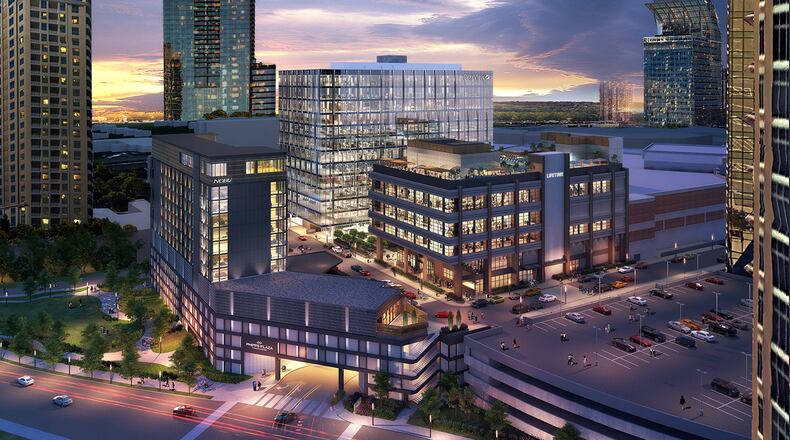Atlanta shoppers who ventured out this holiday season might have noticed something: The imminent death of brick-and-mortar retail is greatly exaggerated.
Toys R Us is gone. Sears is wheezing for survival. Many chains have scaled back stores as consumers buy more online. Some former shopping magnets are struggling: Chilly, partially vacant Gwinnett Place mall in Duluth went days without power this month in several of its remaining shops.
AJC FLASHBACK PHOTOS: RETAILERS TO REMEMBER
Yet there is more retail space here and in every other major U.S. metro area than five years ago. At the same time retail vacancies in metro Atlanta are at the lowest levels in 17 years, according to real estate data firm CoStar.
That’s because many physical shopping areas aren’t going away so far — they’re just changing.
Local landlords have kept their locations mostly full during the economic upswing by relying more heavily on tenants that have been more resistant to click and ship: restaurants, grocers, service providers such as hair and nail salons, doctor offices, workout spaces and pop-up shops such as seasonal retailers.
The retail transformation is still in its early days, say industry insiders. But it’s already reshaping everything from what businesses they land (expect even more food choices and fewer traditional retailers) to what new spaces they build (fewer shopping-only properties and more mixed uses).
A $300 million remake underway at Phipps Plaza, Atlanta's most upscale mall, includes a Nobu hotel and restaurant, an office tower, a sprawling fitness center, more restaurants and a grassed area for gatherings. But it doesn't include any new retail stores. In fact, some of the expansion by Simon Property Group will be on the former site of the Buckhead mall's Belk department store.
“It is becoming increasingly more difficult to justify building just a ground-up standalone shopping center,” said Jack Halpern, whose family has been in the Atlanta shopping center business for 60 years.
‘We are under-demolished’
Americans have long been flush with places to shop. U.S. retail space per capita is by far the highest in the world, though that figure has dropped from a 2009 peak.
Metro Atlanta has nearly 59 square feet of retail space per person. That puts it in the highest third for the nation’s largest metro areas, according to CoStar. Still, Atlanta has seen declines in per capita space as the local population grows faster than retail construction.
There could be a bigger reckoning.
E-commerce continues to grow rapidly, accounting for nearly 10 percent of the nation's $1.34 trillion in retail sales in the third quarter. Online giant Amazon is now the nation's third largest retailer, behind only Walmart and Kroger.
Many traditional retailers have struggled to update their brands, handle big debt and deal with consolidation. Mainstays that have faced troubles in recent years include Abercrombie & Fitch, JCPenney and Bed Bath & Beyond.
Average rents at Atlanta shopping centers are lower than highs set in 2007, according to CoStar analyst Brad Raber. And it could become harder to keep vacancies in check once the next recession strikes.
“We are oversupplied on retail space, or, as I like to say, we are under-demolished,” said Jon Wiley, a Georgia State University professor who specializes in commercial real estate.
Indoor malls — particularly lower-tier ones — already have been hit hard. Nationally, mall vacancy rates are the highest since late 2011, according to Reis, a real estate research firm. And occupancy rates at U.S. strip shopping centers have slipped after some post-recession gains.
At Gwinnett Place during last year's Christmas shopping season, a dead woman's body was found near the mall's vacant food court, where police estimated it lay unnoticed for more than a week. This holiday season, an apparent equipment problem caused some of the Duluth mall to go without electricity for days.
Several shop owners temporarily closed as a result.
Not Steve Lee. He wore a winter coat inside his Pinetree Embroidery store and worked by makeshift lamplight using extension cords. Beyond the power outage, he said his business personalizing items such as ball caps and towels has survived because of loyal customers and a category that resists online competition.
“This is kind of a service store, so I think I can manage,” Lee said.
It's a hook that also has appeared to work for Sid and Ann Mashburn. The husband-and-wife team launched a men's clothing store at Atlanta's Westside Provisions District during what turned out to be the beginning of the Great Recession and a downturn for fashion apparel retailers.
They’ve grown to nine men’s and women’s shops in five cities, bolstered by their own clothing designs, personalized service, open-air tailor operations and offerings that range from entry-level Levi’s jeans to handmade Italian suits. They’ve also been choosy about where to locate.
“We wanted to be in a place we could stand out a little bit more and not just be another store in an environment,” Sid Mashburn said.
Mixing uses
Some developers of new retail spaces have looked for ways to skip the cookie-cutter approach. Often, they are part of broader mixed-use projects, such as Atlanta's Ponce City Market, which leans heavily toward food offerings, and North Fulton's Avalon.
“The pace of that change is accelerating,” said Halpern, the 69-year-old chief executive of Halpern Enterprises, which has about 40 shopping centers.
Halpern Enterprises a decade ago demolished Belmont Hills, a once-thriving shopping center his dad bought in Smyrna 50 years ago.
Now, the site includes an elementary school, medical offices, apartments, plans for houses and some retail, though only about a tenth as much as had been there before, and much of it will be restaurants, not shops.
Halpern said his top choices for tenants at his centers are now grocery stores, restaurants and businesses of immigrant entrepreneurs who “do whatever is necessary to succeed in their new homeland.”
Fifteen years ago, groceries would also have been atop his list, he said. But they would have been followed by drug stores, which are now more likely to seek stand-alone sites, and stores that are harder to find now, such as boutiques, small hardware stores and office-supply shops.
Still, even some mixed-use developers are betting on strip shopping centers, particularly those with groceries as anchors.
Jamestown, the developer of Ponce City Market, has purchased traditional shopping centers in North Fulton and Cobb counties.
“We bought them in the belief that neighborhood convenience has a place in the world,” Jamestown President Michael Phillips said.
Centers with retailers that offer great experiences or focus on convenience and services are likely to remain strong, he said. And there are opportunities to create centers that target themes, such as Japanese or Korean food.
“I think we are 30 percent of the way into an evolution of the retail space,” he said.
This story has been updated to clarify a comment from Jamestown’s Michael Phillips.
Why it matters
Changes in how and where Atlantans shop affect a big part of the local landscape and economy. Metro Atlanta has hundreds of shopping centers and more than 350 million square feet of retail space. Nearly 300,000 people work in the retail industry locally. And consumer spending makes up the biggest part of the overall U.S. economy.
About the Author
The Latest
Featured






